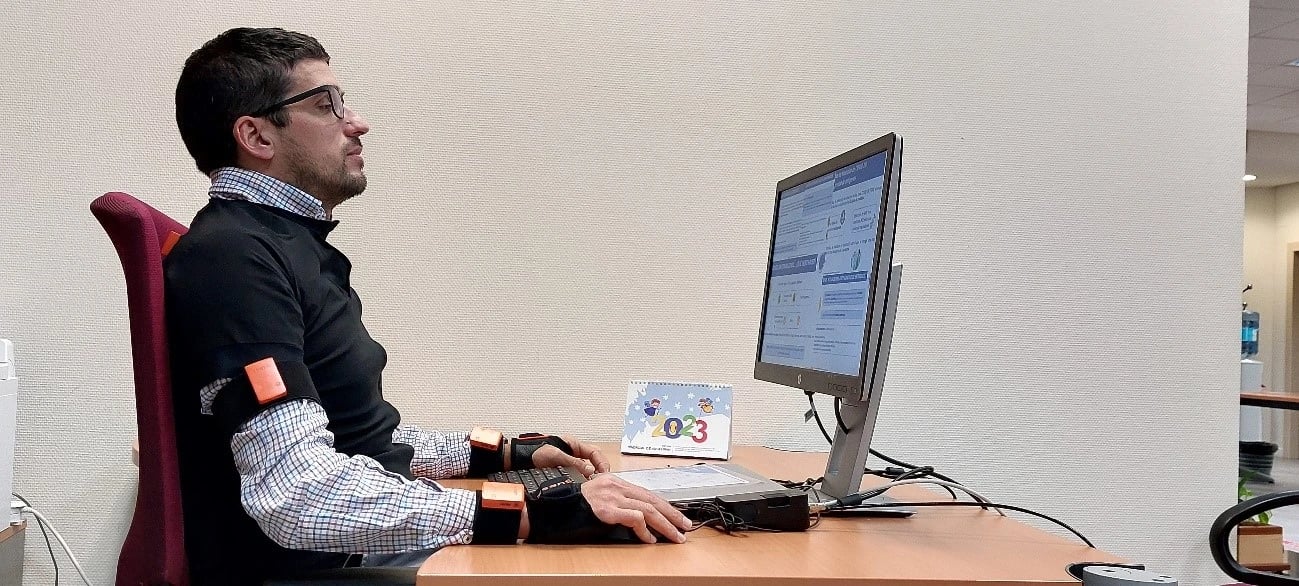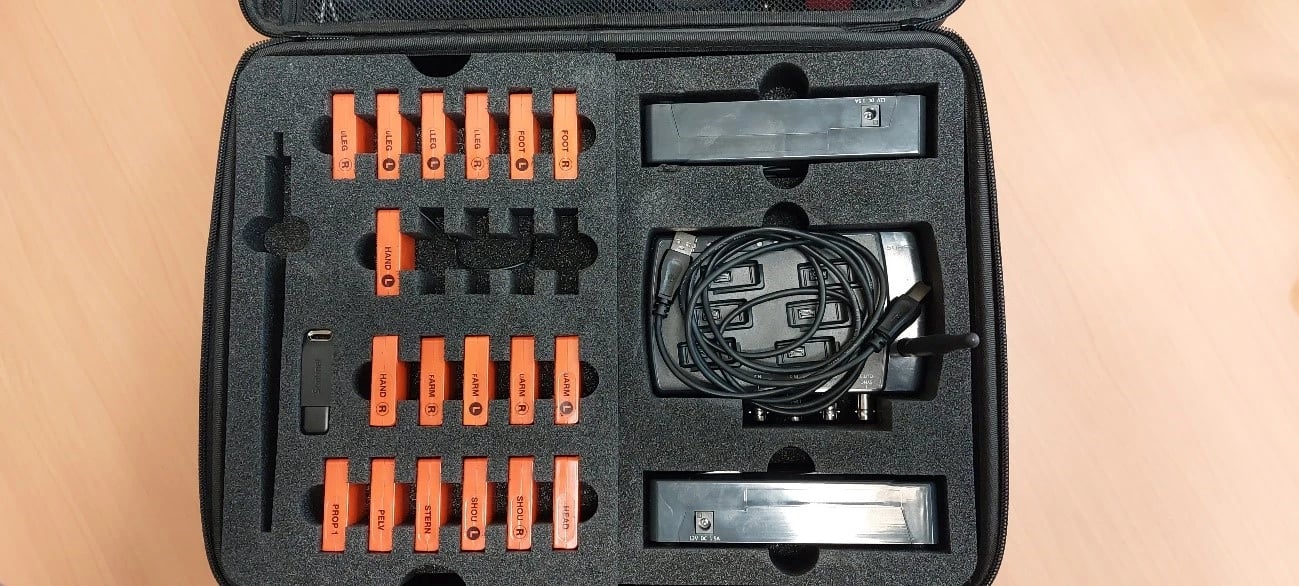FREMAP uses Xsens motion capture to analyze the ergonomic impact of progressive lenses in the workplace and makes recommendations for improvement
The digital revolution has undeniably transformed how we access information and complete tasks, with laptops, tablets, and smartphones becoming ubiquitous companions in both our personal and professional lives. While these devices offer undeniable benefits, their constant use can also pose new challenges to our well-being, raising concerns about potential impacts on visual health and musculoskeletal function.
One emerging area of concern is the intersection of presbyopia, a natural age-related decline in near vision, and the use of progressive lenses. These lenses, often referred to as 'no-line bifocals', provide wearers with a seamless transition between near and far vision, addressing the challenges of presbyopia. However, research suggests that the way we use progressive lenses, with their specific viewing zones, may subtly alter our head and neck postures, potentially leading to discomfort or even musculoskeletal disorders.
To shed light on this issue, FREMAP, a leading Spanish mutual benefit association, embarked on a research study to objectively assess the impact of progressive lenses on occupational health. Their primary objective was to quantify the visual and postural changes associated with using these lenses in a typical workstation environment.
 Worker wearing progressive lenses with the Xsens motion capture sensors to analyze postural changes
Worker wearing progressive lenses with the Xsens motion capture sensors to analyze postural changes
To achieve this objective, the research team, led by National Ergonomics Consultant at FREMAP Prevention, D. Antonio Emir Díaz Martínez, employed Xsens Motion Capture technology, specifically an upper body configuration with 11 strategically placed inertial sensors. This system was integrated with FREMAP's own ergonomics recording, analysis and representation software, utilizing Xsens Analyze Pro for data processing. This setup allowed for the accurate capture and analysis of human movement and posture data.
Antonio Emir Díaz Martínez, commented: "The use of this system allows us to quantify, concisely, precisely, and without interference with normal working conditions, the postural requirements of the cervical spine in workplaces with screens for data visualization. This is thanks to having a software solution that removes the possible interferences caused by local magnetic fields."
By leveraging Xsens Motion Capture, the FREMAP researchers were able to quantify the precise head and neck movements associated with using progressive lenses while interacting with a computer screen.
The research involved monitoring the grazing and cervical spine movements of a worker wearing progressive glasses while they interacted with a computer workstation. To ensure standardized conditions, the upper part of the screen was positioned at eye level, maintaining a distance of 60 cm from the worker. Additionally, the worker's posture was controlled by having them maintain their back against the chair's backrest and their elbows bent at an angle of approximately 80 degrees.
Research Findings and Recommendations
The analysis revealed that participants maintained consistent neck extension throughout the study, exceeding recommended ergonomic limits. This posture is likely linked to the need to look through the lower portion of progressive lenses for optimal near vision. While neck turning remained within acceptable limits, occasional lateral tilts suggest further ergonomic adjustments may be necessary.
Based on the findings, the research makes the following recommendations for progressive lens users.
- Screen Positioning: Ensure the screen is positioned correctly for optimal viewing. Adjust the viewing distance based on task and screen size (400-750 mm for common office monitors). Consider increasing font size for individuals with progressive lenses to increase viewing distance and minimize reliance on the lower lens segment.
- Screen Height: For progressive lens users, reduce the screen height significantly compared to the standard recommendation of aligning the top of the screen with eye level. This helps avoid neck extension for viewing through the lower lens zone.
- Document Holders: Utilize adjustable lecterns or document holders to facilitate switching between digital and printed materials, minimizing strain on eye accommodation.
- Recovery Breaks: Encourage frequent breaks to rest the eyes and change posture, especially for those wearing progressive lenses.
- Occupational Spectacles: For individuals with presbyopia and prolonged digital device use, consider occupational spectacles specifically designed for computer work.
- Training and Awareness: Educate first-time progressive lens users about adaptation exercises and the importance of adjusting their workstation layout. Encourage them to adopt healthy postural habits and avoid extended periods of static posture at their workstation.
By implementing these recommendations, individuals who rely on progressive lenses can create a more ergonomically friendly workspace and potentially mitigate the risks associated with prolonged computer use.
This research project by FREMAP provides valuable insights into the potential impact of progressive lenses on workplace safety. By utilizing advanced motion capture technology like Xsens, the study offers a quantifiable and objective perspective on this complex issue. The findings can help inform future research, guide the development of ergonomic interventions, and ultimately contribute to promoting healthy workplace practices for individuals reliant on progressive lenses.
Xsens motion capture for ergonomics assessments
 Accurate motion data: Xsens Awinda Motion Capture Technology featuring 18 inertial sensors
Accurate motion data: Xsens Awinda Motion Capture Technology featuring 18 inertial sensors
Ensuring proper workplace ergonomics is crucial for employee well-being, regulatory compliance, and increased productivity. This focus stems from the significant prevalence of musculoskeletal disorders (MSDs), often linked to poor ergonomics, affecting nearly 1.71 billion people globally.
However, traditional assessment methods can be time-consuming and rely on subjective observations, potentially hindering accurate risk identification. Xsens Motion capture technology offers a compelling solution. Xsens captures objective and validated data on worker movements, eliminating subjectivity and increasing data collection efficiency. This empowers companies to swiftly identify potential hazards and make informed decisions regarding workplace design and modifications. Ultimately, this fosters safer and more productive workspaces, leading to a thriving and healthy working environment for all.
Learn more about Xsens solutions for workplace occupational health and safety.